A few weeks ago, I stood in the gym of CU Jiu Jitsu, holding a big foam sword. Across from me was Matthew Currey, co-owner of Tempered Mettle Historical Fencing. Currey, also holding a foam sword, was telling me about the four principles of kunst des fechtens, a style of German fencing during the late middle ages and early modern periods. Within just a few minutes — literally less than five — I had a basic understanding of how I (in theory, with practice) could begin to sense what is weak and what is strong in those movements and select an appropriate response.
This micro lesson followed a conversation with Currey during one of Tempered Mettle’s Sunday training sessions. There were several people there practicing this ancient style of fencing — think longswords, not the delicate épée you see during the Olympics. It’s the stuff of history, yes, but also fantasy novels and movies featuring greatly heroic, hypermasculine men. People who obsess over the past generally give me pause, because the past was not very kind to women and people of color, among other marginalized groups. But here in the 21st century, the people practicing on that day were warm and inviting, generous with their time and answers to my many questions. They were curious and welcoming. It was a community of people with similar interests, one that was ready to welcome anyone else — especially women and people of color — who wants to learn more.
I spoke with Currey about the founding of the school, what the heck kunst des fechtens is, and why it’s fun to study. In addition to learning history and the cultural context of this martial art form, you will receive an excellent workout. The next intro class begins May 12th, and you can sign up online.
For a solid idea of what you can expect in a class, read my interview with Currey below. For questions about Tempered Mettle, get in touch through their website, or follow them on Facebook for information about upcoming classes.
This interview has been edited for length and clarity.
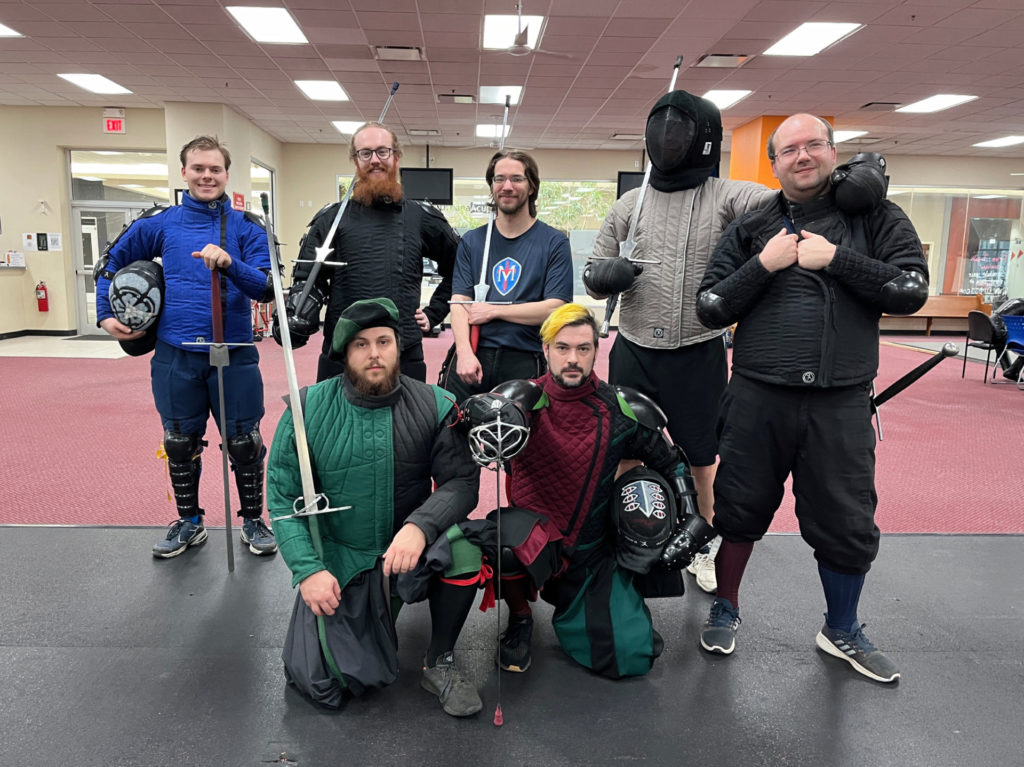
Smile Politely: What is Tempered Mettle Historical Fencing?
Matthew Currey: Tempered Mettle Historical Fencing is a fencing school that is a passion project for me. It’s technically a business, but everything that we pull in goes into improving the school or paying the bills.
We teach what is called kunst des fechtens, or the art of combat, which is a style of fencing that originated in Germany in the 1300s. In that time period it was a secret art intended for the nobility, and it was written down in code, in a poem called the Zettel.
The master that we study from, Joachim Meyer, printed his book, the Gründtliche Beschreibung der Kunst des Fechtens, which means the thorough description of the art of fencing, in 1570. The book is massive, it contains five classes of weapons: longsword, dussack, rapier, dagger, and polearms.
Meyer was part of a movement called the freifechter — that means free fencers — which, before the freifechters came around, the ability to be recognized as a master was only contained to the Brotherhood of Saint Mark. Meyer’s movement was more like, “Hey, we’re really good at this, we’ve been studying this well, we want to recognize our own masters.” It was important to be a fencing master because fencers would compete in a tournament that was essentially meant to show off skills and usefulness as someone who could help to defend the town or the land. Meyer wrote this book at the beginning of the time period when guns started coming onto the battlefield. He saw their value to warfare and was like, “I want to record [this fencing] for the future in its entirety, so that people in the future can know about this and learn this,” and that’s what we’re doing!
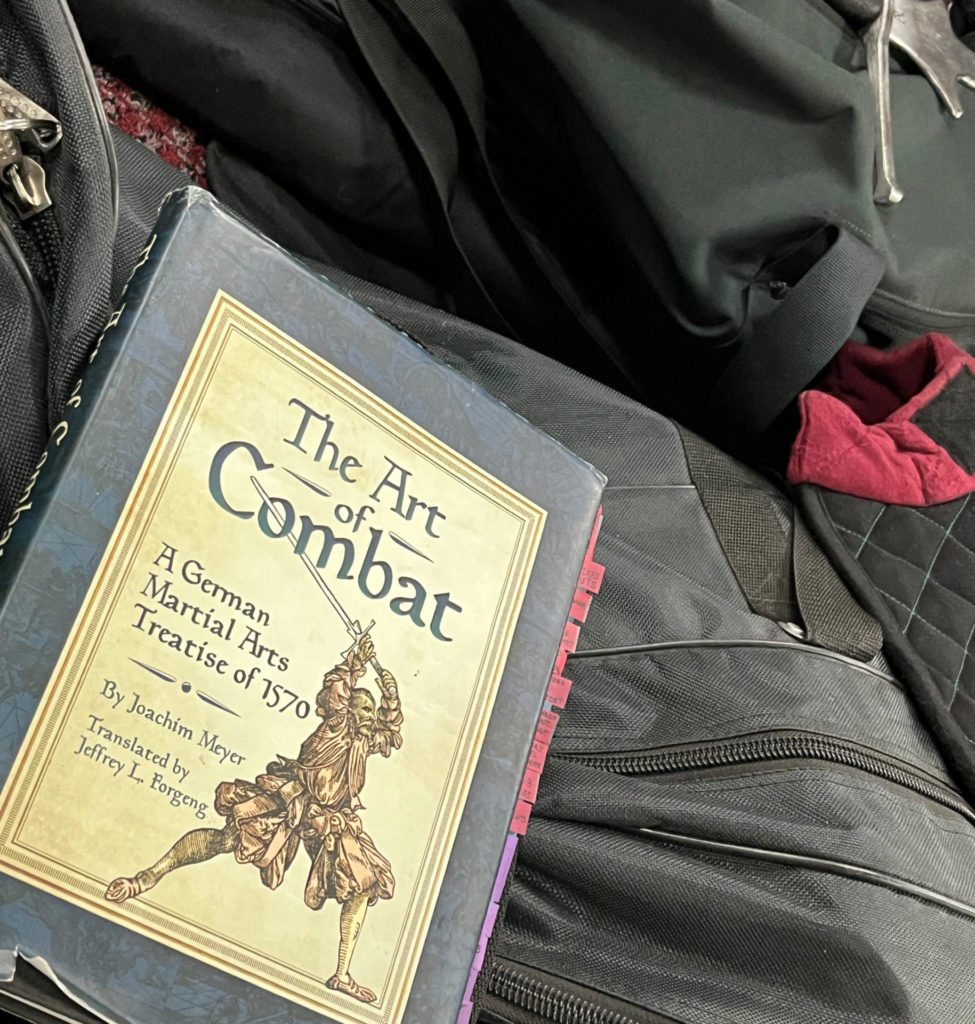
SP: How did you come to it?
Currey: I used to work at Volition, and one day at the end of the day, I saw one of my friends just walk by the end of the hallway carrying a synthetic longsword, and me being a nerd, I sprinted down the hall and was like, “Hey, what are you gonna go do with that?” He said that he studied this thing called HEMA [historical European martial arts] and was going to practice. I was like “That is really cool, how do I get into this?” He gave me a miniature lesson on a cold foggy morning [in March 2016], right up at West Side Park and then I was like, “Holy crap, I want to do this.”
I started showing up to the practices. Back then it was just a couple people meeting in the park — it was technically an RSO called HEMA UC. I was already well out of college by that point, and a year later the person who created that RSO left. [By then]I had already joined the Meyer freifechter guild. My thought was, “If I want to keep doing this, If I don’t do this, it’s going to go away, it’s going to fizzle, and I need this in my life, I need this structure.” At the time, I was just generally depressed and didn’t have any friends outside of work. So I took it over, and over the course of the next year, I helped lead with the new president, I added the structure to the lessons and that was very popular. Our retention went from one in 20 to three in ten. We built up to over 20 people. Just a couple years ago, in 2022, we [were] getting huge and it [was] hard to manage the safety of that many people. I took my best students, who were Jordan Kuneyl, Milosh Djordjevic, and Miles Norsworthy, who also happen to be community members, and I peer pressured them into founding this school with me. I own 50% of it, but they own the rest.
HEMA UC is still around. We’re kind of a hybrid organization now. They pay us for instruction, and we gather together twice a week [at the Stock Pavilion]. [That floor] is wood chips, sometimes it also contains a little bit of animal poop, which I’m pretty sure that combination is historically accurate way to train. The terrain in there is a little bit uneven, but in the end I think that actually helps your footwork and helps you be a little bit more stable. On Sundays [practice is] people who are members of our school.
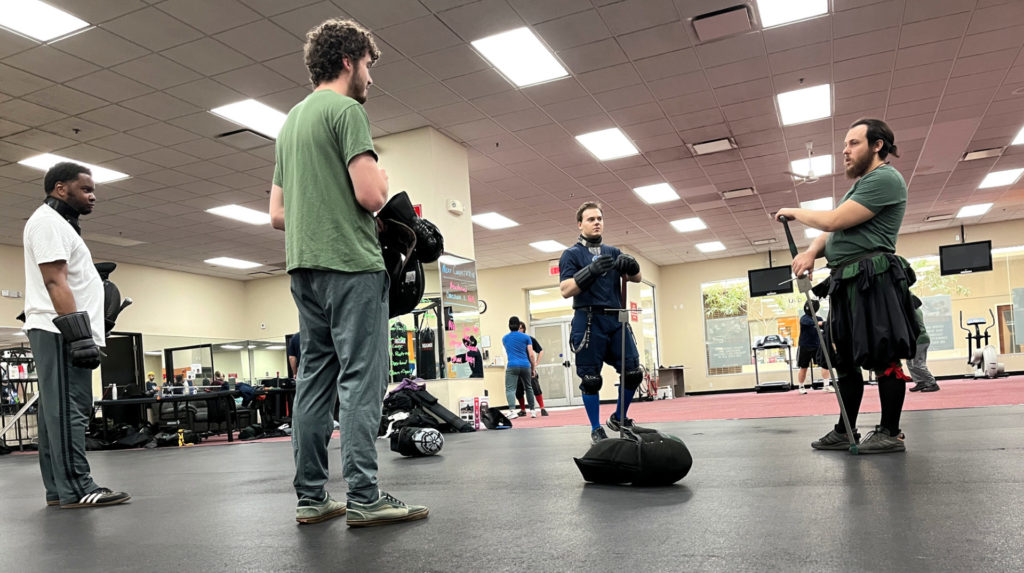
SP: What about this specific type of martial arts did you find so compelling? What about it brought you joy?
Currey: First off, swords. Swords are cool. As a fan of fantasy and video games and all that stuff, it was an excuse to buy swords. I had been interested in martial arts my entire life; I had studied a few over the years.
What I like most about it… The phrase that we would always use is that there are no living masters; I think that’s no longer true. I think people are informed about this enough that there are now living masters again. It’s all about interpretation. We work from that book, we interpret text, and we look at the art. It’s a scientific process. You read the text, you try to figure out what it means, it will reference the art, you look at the art, use that to inform what you think it means, you try it and you fail. Then you read it again. You’ll probably fail again. After a couple of attempts trying to learn the technique, you figure it out and it makes sense. Then, you try it out while you’re fencing with an opponent and you see if it works. When you’ve figured it out, you move on to the next technique and you continue the scientific process.
That to me is very interesting and very cool.
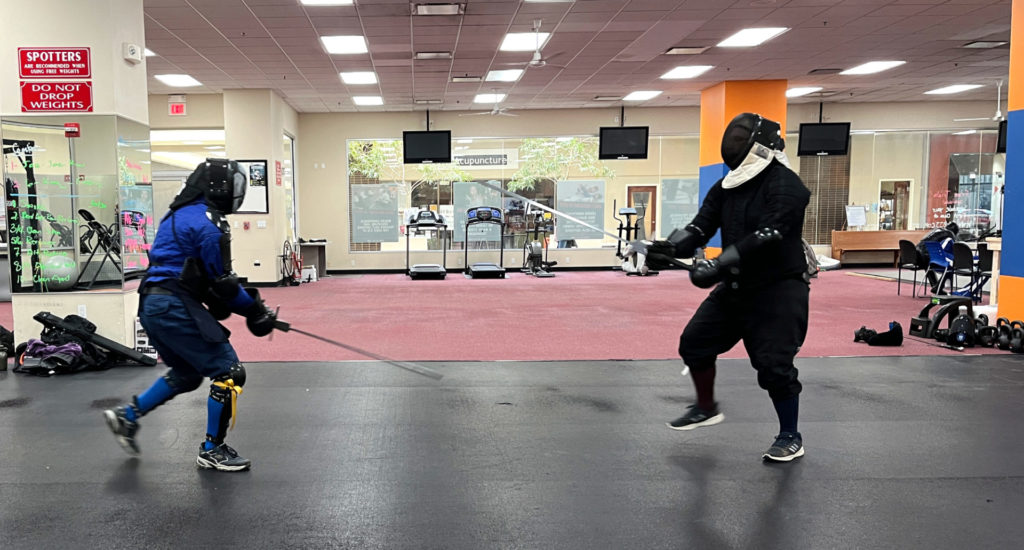
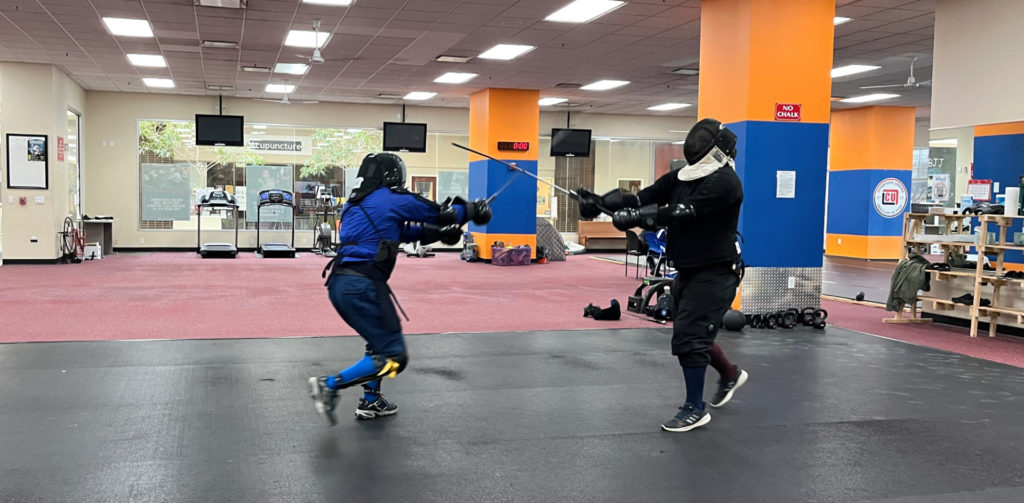
SP: The experiment of it?
Currey: Yes. Because it teaches you to internalize it in a different way than just showing you how to perform a technique. The way that I teach is more like the Socratic method. I help people go through the process that I undertook, and the school is actually able to get people to a place in one year that took me three and a half, four years to get to. I think that is indicative of the success and quality of instruction that we can provide.
SP: What does continuing education look like for instructors?
Currey: I am mostly self-taught. I travel across the Midwest to either take private lessons, or go to educational events and seminars, which are sometimes alongside tournaments. A tournament is an excellent place to test your skills because when you step into the ring with a new person, your first thought is, “Okay, who is this person, and how do they fence?” It’s a little bit of a puzzle. Yes, [instructors] go to private lessons. A few of my mentors just recently released a video series on this website called True Steel, and we’re planning on having a watch party soon.
SP: What have you learned about yourself in doing this type of martial arts?
Currey: As a person with pretty severe ADHD, it’s easy to bounce from hobby to hobby and never really get good at something. With this, I’ve learned that I can stick with something. I’m also a crafter. Crafting is kind of like my zen space, really. The cool thing about crafting is I can jump around, I just jump around between materials. It’s something that helps with [Tempered Mettle], maintaining your gear or modifying your gear to fit your needs. I’ve gotten better at sewing, I’ve gotten better at working with plastics and metals.
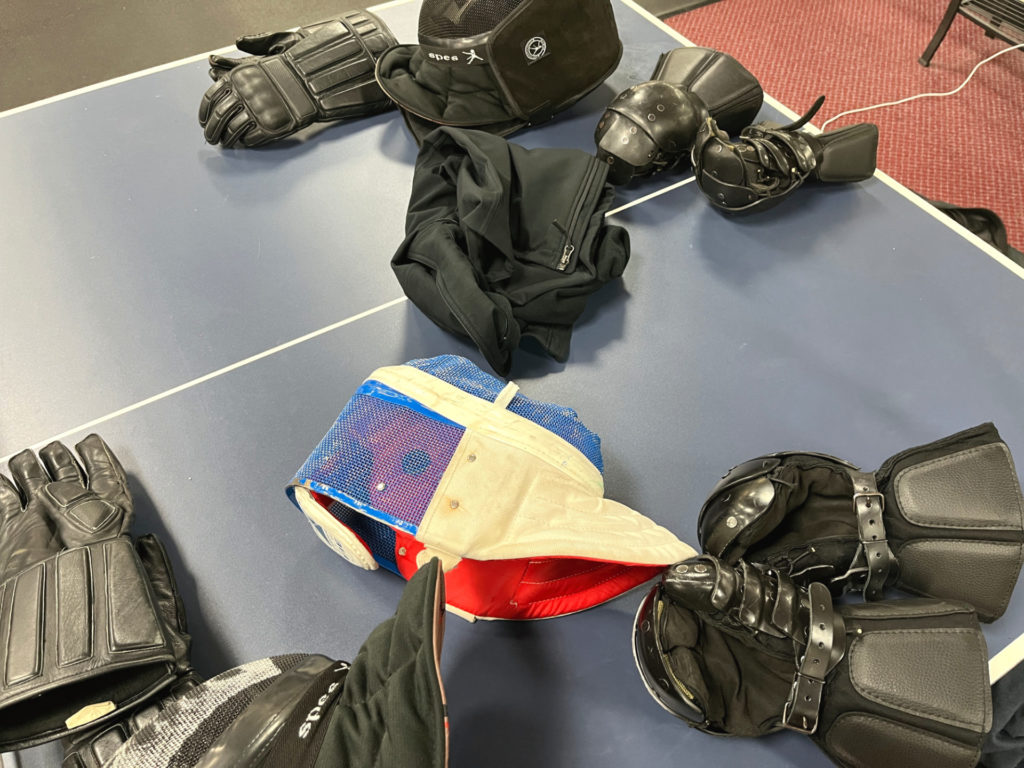
SP: About the gear; what kind of gear do you need?
Currey: When somebody begins, we provide a general timeline for the gear that they need and the purchase order for when they should get it. We do have some loaner gear, but we generally recommend to people, get your mask ASAP. ‘Cause using a loaner mask is kind of gross. Get your gloves immediately after that, cause using loaner gloves is kind of gross. Then after you’ve gotten about a third of the way through the intro course and have a good grasp of the basics, you are getting to the point where you might actually want to start fencing, in earnest. What’s important to me is that you are safe to perform this pretty dangerous martial art. Meaning, you’re not going to hurt yourself, you’re not gonna back peddle like mad and run into somebody behind you, you’re able to calibrate your force. Any blade can hurt someone pretty easily.
Once you’re at that point, you need to get a gorget, which is throat protection; a jacket; I highly recommend plates, but at minimum elbow protection; the heavier style gloves for longswords specifically because there’s not complex hilt to protect your hands; and fencing pants are optional — not pants, pants are not optional — but fencing pants are optional because we’re typically not targeting each other’s legs too much. I do recommend [knee pads], sometimes knees get hit and knees really don’t like to get hit. Obviously you need some sort of groin protection. All in all, you can expect to pay about $1000 for a full set of kit, but it’s spaced out over time. I didn’t get my first full set of kit until I started going to tournaments.
SP: What about the weapons? How does that work?
Currey: We don’t like to call them weapons, really.
SP: Swords?
Currey: Simulators, or federschwert [German for feather sword]. That is the terminology and style of training sword they would have used back then, which is not sharp. It has a tip that is not pointy. It’s a little bit lighter, and a little bit more flexible.
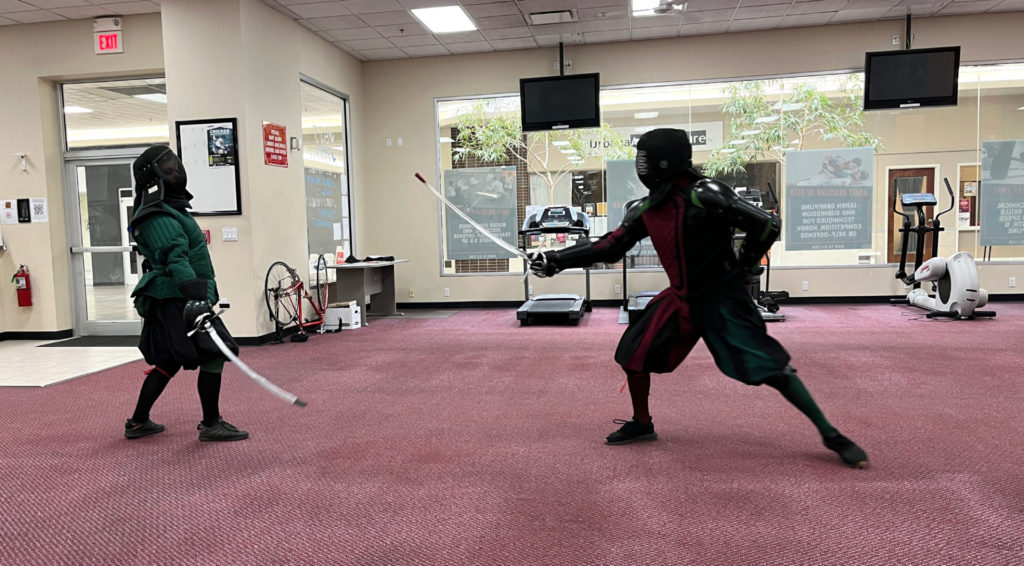
SP: When does a student buy a sword? Do you provide swords?
Currey: We do have some loaner swords. We have foams, some synthetics. The sword is your first major purchase. Some people don’t have any and that’s fine; you can use the loaner gear, that’s why we have it. But generally, people want to buy one, and they want to buy one soon. The order that I typically recommend is mask, gloves, sword.
SP: Can you tell me about your students? Who is your typical student, or is there no such thing as a typical student?
Currey: I would say that there is no typical student, but there are typical qualities in students.
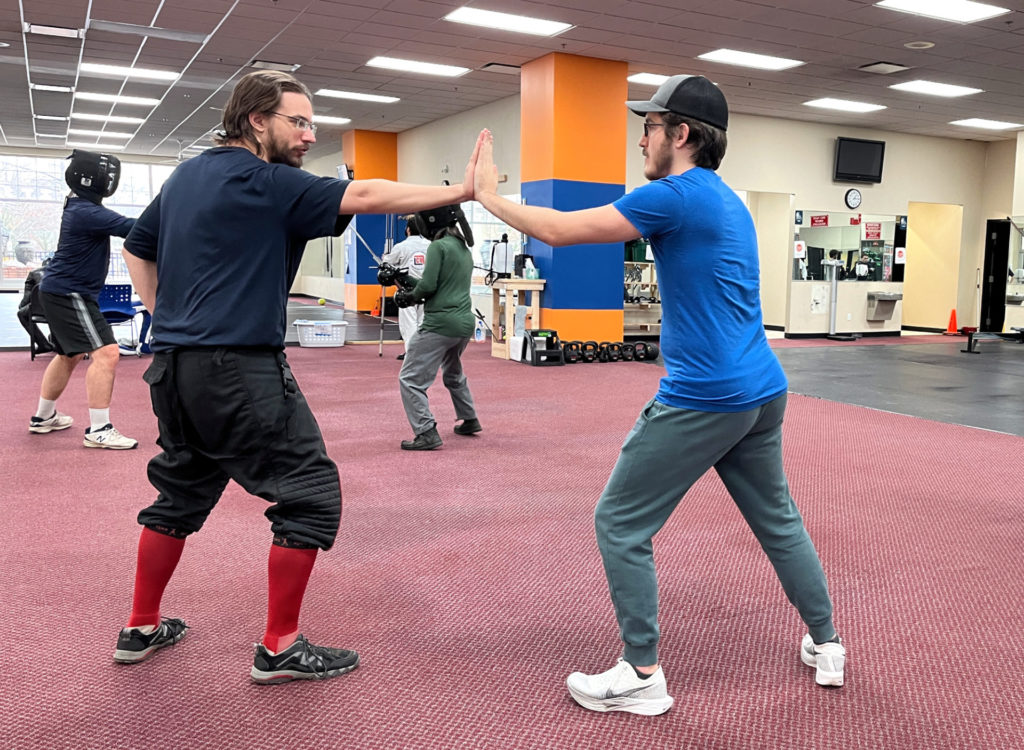
SP: What are those?
Currey: We’re all nerds. [laughs] We are all very enthusiastic, very curious about what any of this is. Generally good natured; we foster a culture of respect and inclusiveness, everyone is allowed to train with us, no matter identity. We don’t teach minors, so 18 and over.
SP: It seems like being curious is probably the most important quality, being flexible to receive instruction.
Currey: Yeah, being a little bit bold. It does take bravery to be willing to stand there, protecting yourself, but knowing you will get hit by a piece of metal. We haven’t had any major injuries — we haven’t even had a broken finger. Everyone gets bruises, but nothing major.
SP: How can people get involved?
Currey: Look out for when our beginning class starts, and attend! [The next intro class begins May 12th, and you can sign up here.] We respect any level of commitment to this martial art, as long as you cross the minimum threshold, which is being enthusiastic about it and showing up as often as you can. Generally, people who show up a few times a month or once a week do well.
SP: Do you stage any competitions or tournaments here?
Currey: Not yet, but our first event will probably be in December.
Sign up for the next beginner class here.








